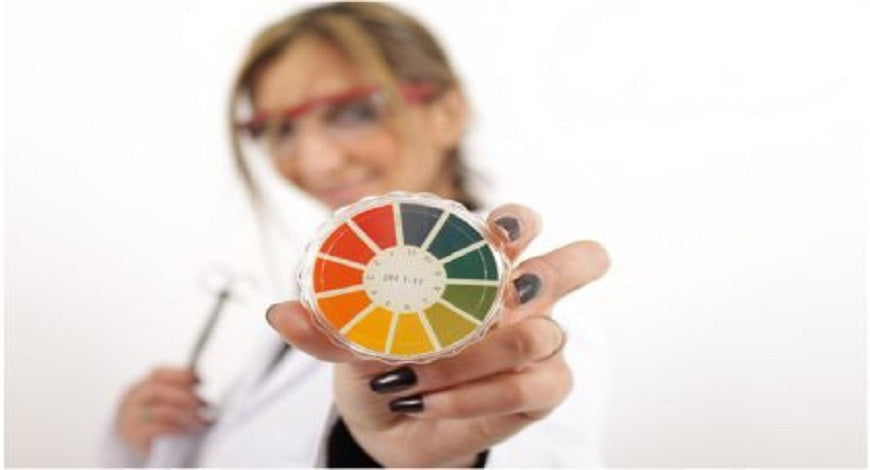Your body pH score represents the amount of acid in your body.
While 7.0 is considered neutral, a score below 7 shows that your body is acidic while a score above indicates you have reduced the acidity to a healthy level.
For the scientifically inclined, pH – or power of hydrogen – is a measurement of the hydrogen ion concentration in your body.
Pure water has an equal number of hydrogen ions and hydroxide ions.
Read on to learn more about body pH, its importance, and how to check body pH level.
The Difference Between Acid and Alkali
An acid is a substance that donates hydrogen ions, so if you mix it with pure water, the water will acquire more hydrogen ions and the hydroxide ions will be overpowered.
An alkali, on the other hand, is a substance that soaks up hydrogen ions and thereby neutralises them. If you mix it with pure water, it will absorb and neutralise some of the water’s hydrogen ions and thereby produce water with more hydroxide ions than hydrogen ions.
If this feels too much like your unintelligible high school chemistry classes, remember only this:
- Your body may have more hydrogen ions than hydroxide ions, and if this is the case, it is too acidic.
- To alkalise it, consult an alkaline food chart and consume between 60-80% foods and drinks that neutralise those hydrogen ions.
If you’re interested in learning more about this topic, check out our article “How to Make an Easy Start on the Alkaline Diet.”
Why is Body pH Important?

The pH score of the average human body is 7.4 (1)
The body's balance between acidity and alkalinity is referred to as acid-base balance (2). Your body has natural pH regulation mechanisms that work hard to maintain the level of 7.4. If you eat too much acidic and too little alkaline food, your body has to steal alkaline substances from its own tissue to neutralise the excess acid.
Potassium, calcium and magnesium, for example, are three powerful alkalis. If you consume too much acid, your body must loot potassium, calcium and magnesium from its own bones and tissue to force its pH back to the ideal 7.2/7.4 pH range.
A whole range of ailments have been linked with acidity in the body (3)
If there are too few alkaline minerals in your digestive tract, you suffer indigestion and gastric reflux (4).
If there is too much acid in your blood, your body must line the arteries with fat to prevent them from being corroded. This increases the likelihood of heart disease.
If your body must borrow calcium and magnesium from its bones to neutralise excessive acid, you may be at risk of losing bone density and developing osteoporosis. A study in 2021 (5) concluded that: drinking alkaline water improves spine T-scores in postmenopausal women with osteoporosis. Hence, alkaline water can be used to treat osteoporosis due to increased bone density in postmenopausal women. Long-term interventions are necessary to confirm the effects of alkaline water on femur density.
Pathogenic bacteria also thrive in moderately acid environments, which leads to various types of inflammatory disease including arthritis (6)
Gut bacteria have also been linked with depression (7) anxiety and other psychological and cognitive disorders.
It is not only unhealthy dieting that leads to body acidity.
Some essential physiological processes produce acid too. When you exercise, which is vital to stay healthy, your body produces lactic acid. Lactic acid is an acid which your body then has to neutralise.
Your immune system produces acidic by-products when it protects you from illness.
Your digestive system produces acids to digest your food.
The importance of consuming alkaline substances to help your body neutralise all these basically necessary acids should be clear.
It is, therefore, vital to test your own body pH levels to enable you to alkalise your body.
How to Check Body pH Level
To test your pH level here are two common pH tests you can do yourself at home:
• A Urine pH Test. This pH testing kit consists of either strips of paper, or a roll of paper from which one can tear strips.
It is quite similar to a home pregnancy test. Tear off a strip of paper then urinate directly on it or – less messily – collect your urine in a cup and dip the paper in it. The paper will change colour as it collects water.
Every test kit has a chart that associates these colours with numbers on a pH scale. Check the number that appears next to your test strip’s colour on this chart to obtain your pH score.
The most accurate scores are obtained from urine collected first thing in the morning, before eating and drinking and after at least six hours of sleep. The best score is somewhere between 6.5 (which is quite acidic and should ideally be raised) and 7.5.
• A Saliva pH Testing Kit. A saliva test is performed with the same paper strips as a urine test. It is ideal for people who cannot go for six hours without urinating or who cannot go throughout the night without drinking.
Do not eat, drink or brush your teeth directly before doing the test. Rinse your mouth with water, spit it out and rinse again.
Tear off a strip of test paper and spit on it, or collect your saliva on a spoon and dip the paper in it. Match the colour of the paper with a score on the test kit’s pH chart to obtain your pH score.
A good score is between 7.0 (which is completely neutral) and 7.5.
Keep the Following in Mind when Testing Body pH
• Measure your body pH twice a week and keep a personal chart to record changes over time. For a more complete chart, record your diet along with your body pH. It will help you to fine-tune your diet until you know exactly how much acid you can get away with consuming.
• Your urine and saliva scores differ, so do not record them on the same chart. Your urine contains waste that your kidneys have selected for excretion, so your urine usually contains more acid than your saliva, which continues to circulate in your body.
• Some specialists recommend that you test your pH level daily or even multiple times a day. Others suggest that such frequent testing yields meaningless scores.
We tend to agree with the latter, since your pH level varies throughout the day depending on your food and beverage consumption and the speed at which your body absorbs food (which is not the kind of information you have about your body).
Further, daily testing of pH levels might be an incredibly frustrating experience, because one’s overall body pH changes quite slowly over time in response to dietary changes.
You may therefore see no change from day to day and abandon the exercise due to a perceived lack of progress. The best approach is to test twice or three times a week to ensure that the test records your progress properly.
• If you have never prioritised alkaline food and water, you might be shocked to find a body pH score far below neutral. The average diet in industrialised countries contains an enormous amount of acid food and drinks.
For example, carbonated soft drinks have a pH score of 2.4, coffee scores 4.0, everything made with bleached flour or sugar, such as white and most brown breads, doughnuts and muffins, scores 4.0, red meats score 4.0, milk and cheese score around 5.0, and so on.
On the other end of the scale, almost no food ranks above 8.5. Since 2.4 and 4.0 are further below neutral than 8.5 is above neutral, it is normal for your body pH to be very low at this stage.
It also shows why progress towards a higher pH is so slow once you adopt an alkaline diet; alkaline foods struggle to overpower such extreme acids. Do not allow your low body pH score to overwhelm you; it signifies only that you can be a lot healthier and function a lot better and by making simple alkalising dietary changes.
• Children usually have a higher body pH than adults, and unless seniors have specifically prioritised calcium and magnesium in their diets, they score lower than adults.
All age groups should have a body pH of around 7.4, which simply means that seniors may have to work harder to eat alkaline.
Techniques to Raise Your Body's pH

There are many things you can do to maintain your pH balance:
• Obtain an acid-alkaline food chart and eat primarily foods that are alkaline.
• Limit your alcohol intake.
• Obtain an alkaline water filter to alkalise the tap water you drink and cook with.
• Exercise regularly.
• Reduce stress
• Obtain an alkalising mineral supplement that contains especially bioavailable calcium and magnesium.
Conclusion
An alkaline body is a healthier body. Without testing your body pH and recording your progress, you cannot alkalise your body properly, since you will never know whether you are eating the correct food and neutralising those acids effectively.
Once you have acquired a test kit, you can convert your body to one that functions optimally.
pH Test Strips will help you determine your blood/saliva pH, while pH test reagent lets you clarify the pH of your drinking water.
Your journey towards better pH balance starts now.
While body pH testing can reflect dietary impact on the body, it doesn’t provide a complete health assessment. If you have serious health concerns related to acidity or alkalinity we would advise you to consult your healthcare professional.
Written by Amy Morris, BSc (Hons) Nutritional Therapy. Amy has been a nutritional therapist for 12 years, specialising in recent years as a functional medicine nutritional therapist. Women’s health, and pre-diabetes and type 2 diabetes prevention are Amy’s specialist areas. Diagnosed with a chronic condition called endometriosis at age 20, this is what motivated Amy to study nutrition. Amy has been in remission for 6 years now, attributing powerful nutrition, lifestyle and bio-identical hormone strategies she now shares with her clients. https://www.instagram.com/greathealthnaturally/
Water for Health Ltd began trading in 2007 with the goal of positively affecting the lives of many. We still retain that mission because we believe that proper hydration and nutrition can make a massive difference to people’s health and quality of life. Click here to find out more.
Updated 30.1.25
Sources:
1. Hopkins E, Sanvictores T, Sharma S. Physiology, Acid Base Balance. [Updated 2022 Sep 12]. In: StatPearls [Internet]. Treasure Island (FL): StatPearls Publishing; 2024 Jan-. Available from: https://www.ncbi.nlm.nih.gov/books/NBK507807/
2. James L Lewis III, MD. MSD Manual. (2023) Overview of Acid-Base Balance. https://www.msdmanuals.com/home/hormonal-and-metabolic-disorders/acid-base-balance/overview-of-acid-base-balance
3. Medical News Today (2019) What to Know About Acidosis. https://www.medicalnewstoday.com/articles/326975#risk-factors
4. Koufman JA, Johnston N. (2012) Potential benefits of pH 8.8 alkaline drinking water as an adjunct in the treatment of reflux disease. Ann Otol Rhinol Laryngol. 2012 Jul;121(7):431-4. doi: 10.1177/000348941212100702. PMID: 22844861. https://pubmed.ncbi.nlm.nih.gov/22844861/
5. Fasihi S, Fazelian S, Farahbod F, Moradi F, Dehghan M. (2021) Effect of Alkaline Drinking Water on Bone Density of Postmenopausal Women with Osteoporosis. J Menopausal Med. 2021 Aug;27(2):94-101. doi: 10.6118/jmm.20036. PMID: 34463073; PMCID: PMC8408322. https://pmc.ncbi.nlm.nih.gov/articles/PMC8408322/
6. Li S, Yu Y, Yue Y, Zhang Z, Su K. (2013) Microbial Infection and Rheumatoid Arthritis. J Clin Cell Immunol. 2013 Dec;4(6):174. doi: 10.4172/2155-9899.1000174. PMID: 25133066; PMCID: PMC4131749. https://pmc.ncbi.nlm.nih.gov/articles/PMC4131749/
7. Carabotti M, Scirocco A, Maselli MA, Severi C. (2015) The gut-brain axis: interactions between enteric microbiota, central and enteric nervous systems. Ann Gastroenterol. 2015 Apr-Jun;28(2):203-209. PMID: 25830558; PMCID: PMC4367209. https://pmc.ncbi.nlm.nih.gov/articles/PMC4367209/




























Leave a comment